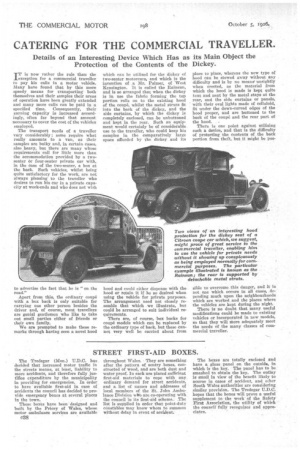CATERING FOR THE COMMERCIAL TRAVELLER.
Page 60

If you've noticed an error in this article please click here to report it so we can fix it.
Details of an Interesting Device Which Has as its Main Object the Protection of the Contents of the Dickey.
IT is now rather the rule than the exception for a commercial traveller to pay his calls in a motor vehicle. Many have found that by this more speedy means for transporting both themselves and their samples their areas of operation have been greatly extended and many more calls can be paid in a specified time. Consequently, their earning capacity is increased accordingly, often far beyond that amount necessary to cover the cost of the vehicles employed.
The transport needs of a traveller vary considerably; some require what really amounts to a van, as their samples are bulky and, in certain cases, also heavy, but there are many whose requirements call for little more than the accommodation provided by a twoseater Or four-seater private car with, in the case of the two-seater, a box at the back. Such vehicles, whilst being quite satisfactory for the work, are not always pleasing to the traveller who desires to run his car in a private capecity at week-ends and who does not wish to advertise the fact that he is "on the road."
Apart from this, the ordinary coupe with a box back is only suitable for carrying one other person besides the driver and, of course, most travellers are genial gentlemen who like to take out small parties either of friends or their own family.
We are prompted to make these remarks through having seen a novel hood which can be utilized for the dickey of two-seater motorcars, and which is the invention of a Mr. Palmer, of West Kensington. It is called the Rainsun, and is so arranged that when the dickey is in use the fabric forming the top portion rolls on to the existing hood of the coupe, whilst the metal struts fit into the back of the dickey, and the side curtains, by which the dickey is completely enclosed, can -be unbuttoned and kept in the rear. Such an equipment would certainly be of considerable use to the traveller, who could keep his samples in the comparatively large space afforded by the dickey and its
hood and could either dispense with the hood or retain it if he so desired when using the vehicle for private purposes. The arrangement need not closely resemble that which we illustrate, but could be arranged to suit individual requirements.
There are, of course, box backs for coupe models which can be replaced by the ordinary type of back, but these cannot very well be carried about from place to place, whereas the new type of hood can be stowed away without any difficulty and is by no means' unsightly when erected, as the material from which the hood is made is kept quite taut and neat by the metal stays at the rear, and the side curtains or panels, with their oval lights made of celluloid, fit under the down-curved edges of the hood proper, and are buttoned to the back of the coupe and the rear part of the hood. .
There is one point against utilizing such a device, and that is the difficulty of protecting the contents of the back portion from theft, but it might be pos sible to overcome this danger, and it is not one which occurs in all cases, depending much upon the neighbourhoods which are worked and the places where the vehicles are kept dnring the night.
There is no doubt that many useful modifications could be made to existing vehicles or incorporated in new models. so that they will More adequately meet the needs of the many classes of commercial traveller.












































































































